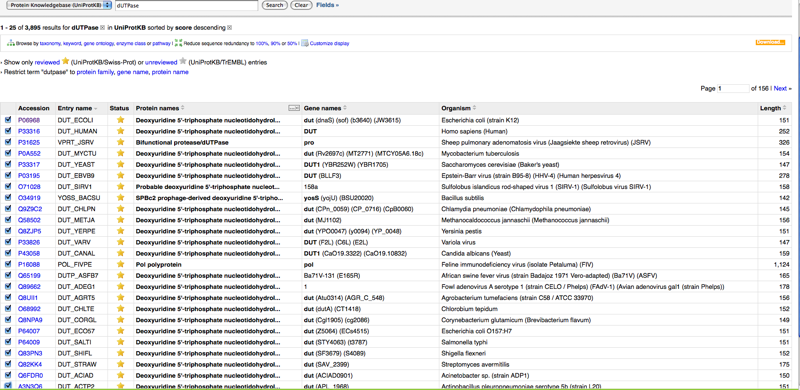Angela A. Garibaldi Week 8: Difference between revisions
From OpenWetWare
Jump to navigationJump to search
(→Working with a single protein sequence: add pgs) |
(→ORFing your DNA Sequences: add ss) |
||
| Line 29: | Line 29: | ||
#Go to [http://www.ncbi.nlm.nih.gov/gorf/gorf.html NCBI ORF Finder] | #Go to [http://www.ncbi.nlm.nih.gov/gorf/gorf.html NCBI ORF Finder] | ||
#Input a DNA sequence for practice | #Input a DNA sequence for practice | ||
I input the following sequence: > | I input the following sequence for the gp120 portion of the gp160: >P04578|33-511 | ||
KLWVTVYYGVPVWKEATTTLFCASDAKAYDTEVHNVWATHACVPTDPNPQEVVLVNVTEN | |||
FNMWKNDMVEQMHEDIISLWDQSLKPCVKLTPLCVSLKCTDLKNDTNTNSSSGRMIMEKG | |||
EIKNCSFNISTSIRGKVQKEYAFFYKLDIIPIDNDTTSYKLTSCNTSVITQACPKVSFEP | |||
IPIHYCAPAGFAILKCNNKTFNGTGPCTNVSTVQCTHGIRPVVSTQLLLNGSLAEEEVVI | |||
RSVNFTDNAKTIIVQLNTSVEINCTRPNNNTRKRIRIQRGPGRAFVTIGKIGNMRQAHCN | |||
ISRAKWNNTLKQIASKLREQFGNNKTIIFKQSSGGDPEIVTHSFNCGGEFFYCNSTQLFN | |||
STWFNSTWSTEGSNNTEGSDTITLPCRIKQIINMWQKVGKAMYAPPISGQIRCSSNITGL | |||
LLTRDGGNSNNESEIFRPGGGDMRDNWRSELYKYKVVKIEPLGVAPTKAKRRVVQREKR | |||
[[Image:ORFfinderSS.jpg]] | |||
Compare your results with the SWISS-PROT entry you found for the protein above to decipher what the output means. ExPASy also has a translation tool you can use [http://www.expasy.org/tools/dna.html here] | Compare your results with the SWISS-PROT entry you found for the protein above to decipher what the output means. ExPASy also has a translation tool you can use [http://www.expasy.org/tools/dna.html here] | ||
*Based on the ExPASy tool | *Based on the ExPASy tool: | ||
[[Image:ExpasySS.jpg]] | |||
==Working with a single protein sequence== | ==Working with a single protein sequence== | ||
Revision as of 22:52, 14 March 2010
Retrieving Protein Sequences
- Go to UniProt UniProt
- Enter dUTPase in search window. This produces more than 3 relevant sequences, so found DUT ECOLI (P06968) on page 4
- Scroll down for FASTA format of amino acid sequences
- In the case that your beginning information is not enough to find the protein sequence you seek,
- find the advanced search option. This no longer exists. You have to click the add and search button and a drop down menu will be displayed to give you the same search options as described in Figure 2-16 of the Bioinformatics for Dummeies
Retrieving a List of Related Protein Sequences
- Go to the Advanced Search UniProt as described above
- Because the advanced search is completely different, cannot deselect TrEMBL. Instead Select Reviewed- Yes as an alternative
- Input dUTPase in search again. There is no "description" field any longer.Yields many possibilities
- Since there are more than 211 total possibilities, so we selected entire first page of sequences (25)
- In newer version click retrieve at the bottom right corner instead of french button.
- Once you retrieve these, it is put into a list of which you can add to and then below choose the format you want the sequences in. No longer have to copy and paste into a document. FASTA format is available.
Reading a Swiss-Prot Entry
This time we skipped the example and did the activity using HIV gp120.
- Select the Reviewed - Yes. Our overall query to achieve these results: HIV gp120 AND reviewed:yes
- We selected the first option in the list
Entry Name: ENV_HV1H2 Accession Number: P04578
- Scroll down to Sequence Annotation - Region to Look at V3 sequence specifically.
ORFing your DNA Sequences
- Go to NCBI ORF Finder
- Input a DNA sequence for practice
I input the following sequence for the gp120 portion of the gp160: >P04578|33-511 KLWVTVYYGVPVWKEATTTLFCASDAKAYDTEVHNVWATHACVPTDPNPQEVVLVNVTEN FNMWKNDMVEQMHEDIISLWDQSLKPCVKLTPLCVSLKCTDLKNDTNTNSSSGRMIMEKG EIKNCSFNISTSIRGKVQKEYAFFYKLDIIPIDNDTTSYKLTSCNTSVITQACPKVSFEP IPIHYCAPAGFAILKCNNKTFNGTGPCTNVSTVQCTHGIRPVVSTQLLLNGSLAEEEVVI RSVNFTDNAKTIIVQLNTSVEINCTRPNNNTRKRIRIQRGPGRAFVTIGKIGNMRQAHCN ISRAKWNNTLKQIASKLREQFGNNKTIIFKQSSGGDPEIVTHSFNCGGEFFYCNSTQLFN STWFNSTWSTEGSNNTEGSDTITLPCRIKQIINMWQKVGKAMYAPPISGQIRCSSNITGL LLTRDGGNSNNESEIFRPGGGDMRDNWRSELYKYKVVKIEPLGVAPTKAKRRVVQREKR
Compare your results with the SWISS-PROT entry you found for the protein above to decipher what the output means. ExPASy also has a translation tool you can use here
- Based on the ExPASy tool:
Working with a single protein sequence
Utilizing Bioinformatics for Dummies pages 159-195
- Go to [1]
- Click protParam near top of page
- Enter sequence into space provided or by pasting the accession number. DO NOT INCLUDE THE FASTA FORMAT FIRST LINE, ONLY RAW DATA.
- Compute parameters




